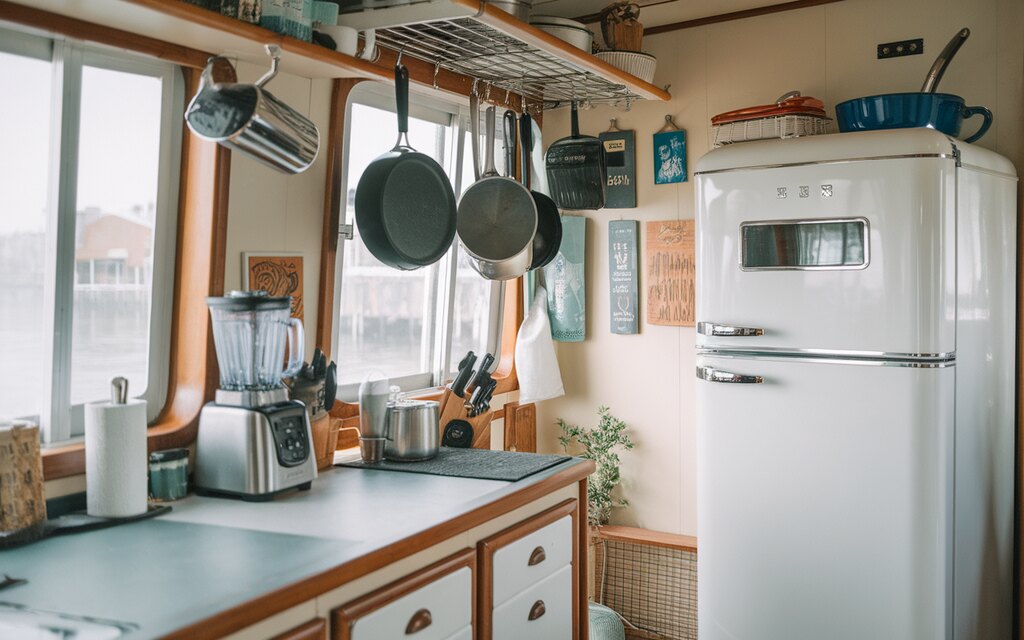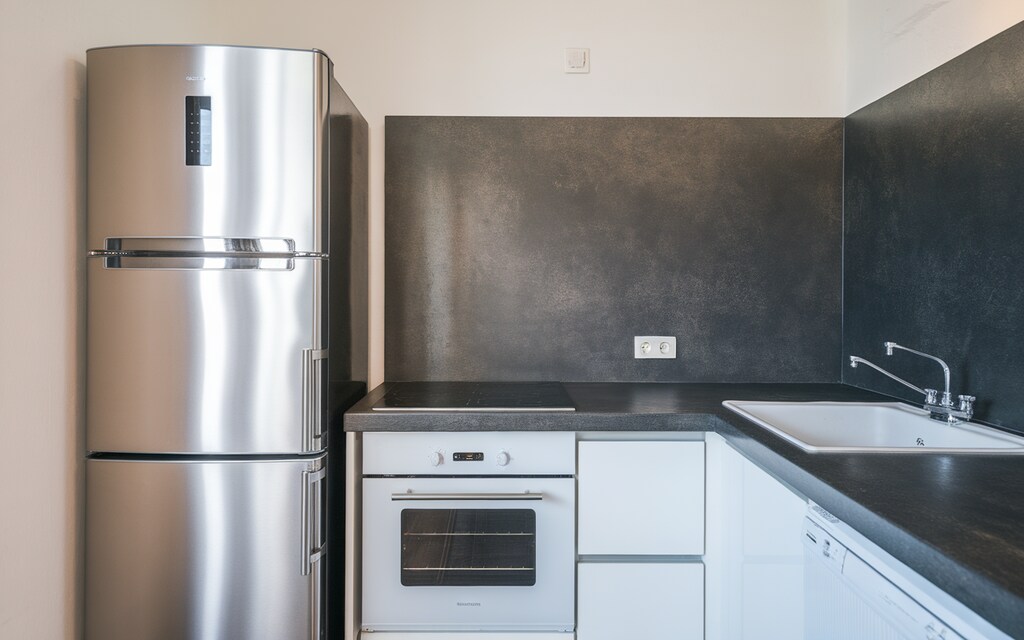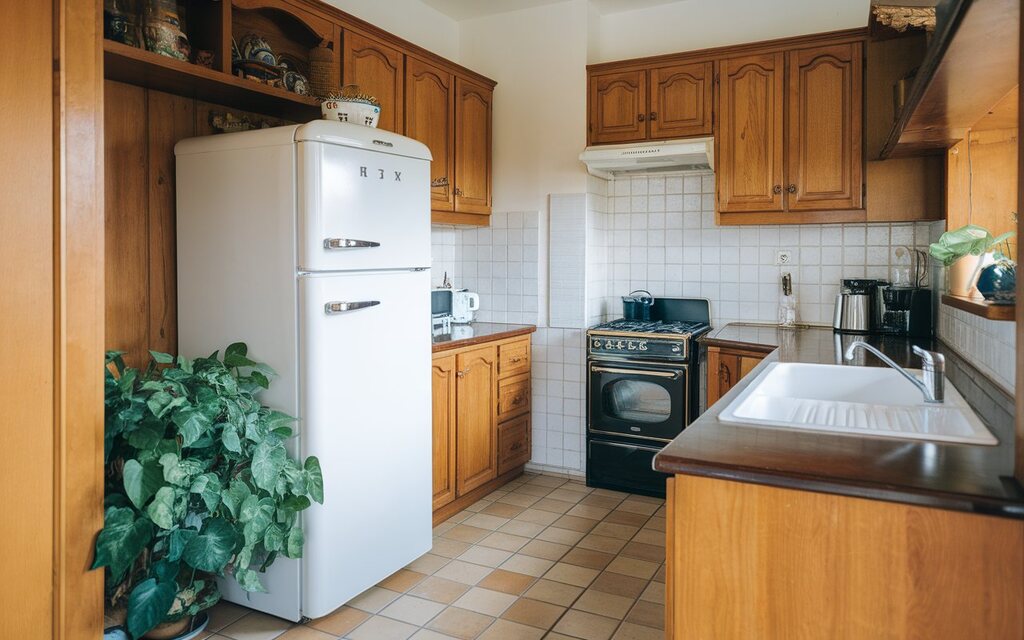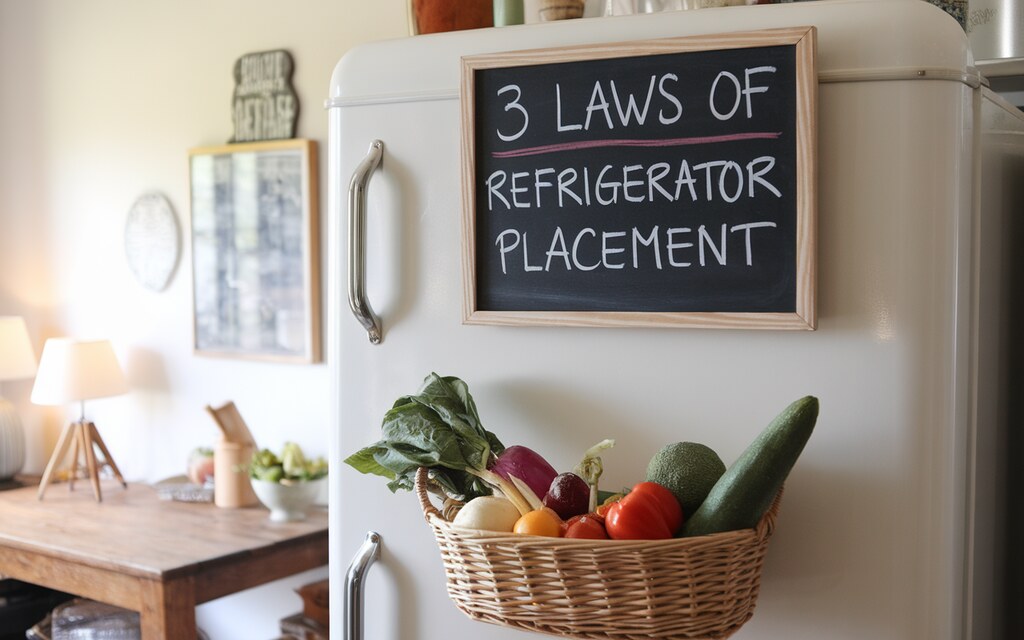Have you ever wondered if your fridge is in the wrong spot? You’re not alone. Many homeowners struggle with this common kitchen dilemma.
In this article, I’ll walk you through the 3 essential laws of refrigerator placement that can transform your kitchen’s functionality. You’ll learn exactly where your fridge should go for maximum efficiency, safety, and convenience.
As a kitchen designer with 15 years of experience, I’ve seen the dramatic difference proper fridge placement makes in hundreds of homes. The solutions I’m sharing have helped families reduce energy bills, make cooking easier, and create more harmonious kitchens.
Whether renovating your kitchen or simply questioning your current layout, these practical guidelines will help you make smart decisions about your refrigerator’s location. No complicated jargon, just straightforward advice you can use today.
How Can I Follow the 3 Laws of Refrigerator Placement?

I’ve helped hundreds of homeowners set up their kitchens. One thing I notice time and again: refrigerator placement can make or break your kitchen experience.
You might think putting a fridge anywhere it fits is fine. It’s not that simple.
Let me show you how to do it right.
The 3 Laws of Refrigerator Placement
These three rules will guide you to the perfect spot for your refrigerator. Follow them closely!
Accessibility is Key
Your refrigerator should be easy to reach for everyone in your home.
Think about this: How often do you open your fridge each day? Ten times? Twenty? More?
Place your refrigerator where:
- You can fully open the door(s) without hitting walls or cabinets
- Items inside are visible without straining
- Children and adults can both reach it easily
- It’s not blocked by furniture or other appliances
Bad placement forces you to walk around islands or counters just to grab milk.
A corner location often works well. Keep it near the entrance to your kitchen when possible.
Mind the Work Triangle
The work triangle connects your sink, stove, and refrigerator. This triangle should flow smoothly.
Your refrigerator forms one point of this important triangle.
The golden rule: The total distance between all three points should be between 12 and 26 feet.
Too close? Your kitchen feels cramped.
Too far? You waste time and energy walking back and forth.
I recommend putting your fridge:
- Within 4-9 feet of your sink
- Not directly next to your stove or oven
- Close to your food prep area
This setup makes cooking faster and more fun.
Allow for Proper Ventilation and Clearance
Your refrigerator needs to breathe. Without proper air flow, it works harder, costs more to run, and breaks down faster.
Critical measurements to remember:
- At least 1 inch of space behind the refrigerator
- At least 1-2 inches above (check your model’s manual)
- Enough side clearance for the door hinges to work properly
Don’t push your fridge tight against the wall or cabinets.
Hot spots matter too. Keep your refrigerator away from:
- Direct sunlight
- Ovens and dishwashers
- Heating vents
- Radiators
I once saw an electric bill drop by $15 monthly just from moving a fridge away from a sunny window!
Following these three laws will help your refrigerator run better, last longer, and make your kitchen work for you instead of against you.
Where Should a Refrigerator Be Placed in a Kitchen?
The perfect spot for your refrigerator depends on your kitchen’s layout. Not all kitchens are created equal.
Think about how you move in your kitchen. Where do you prep food? Where do you cook? Your fridge should fit into this pattern.
Most important rule: Your refrigerator should be at the entrance of your work area – not in the middle of it.
This makes it easy to:
- Grab the ingredients when you start cooking
- Put away groceries when you come home
- Get drinks without crossing the cooking zone
Let me break down the best spots based on your kitchen shape.
Refrigerator Placement in a Galley Kitchen

Galley kitchens are narrow with counters on both sides. Space is tight here!
In a galley kitchen, I recommend placing your refrigerator:
- At one end of the galley
- Near the entrance, when possible
- On the same side as your pantry, if you have one
Bad idea: Putting your fridge in the middle creates a bottleneck.
My client Sarah put her fridge at the end of her galley kitchen. Now two people can work without bumping into each other.
Keep your work triangle compact. In a galley, your total triangle distance should stay closer to the 12-foot minimum than the 26-foot maximum.
Refrigerator Placement in a U-Shaped Kitchen

U-shaped kitchens give you three walls of work space. You have options here!
The best spots for your refrigerator in a U-shaped layout are:
- On one of the “ends” of the U
- Near the entrance to the kitchen
- Opposite to your stove/oven when possible
Avoid the back wall unless your U is very shallow. Putting your fridge at the bottom of the U forces you to walk in just to get something simple.
U-shaped kitchens give you enough room to follow the ventilation law easily. Make sure to:
- Leave proper clearance on all sides
- Keep the fridge away from windows on the U walls
- Ensure doors can open without hitting counters
I once rearranged a U-shaped kitchen where the refrigerator was at the back wall. Moving it to one end saved the family hundreds of steps each day.
Refrigerator Placement in an L-Shaped Kitchen

L-shaped kitchens are common and flexible. Your refrigerator works well in several spots.
For L-shaped kitchens, place your refrigerator:
- At the end of either leg of the L
- On the same wall as your pantry, when possible
- Away from the corner where the two legs meet
The corner is for workspaces, not large appliances. This area is valuable for food prep.
In L-shaped kitchens, you can often create a perfect work triangle by putting:
- Your sink is on one leg of the L
- Your stove is on the other leg
- Your refrigerator is at one of the ends
This creates smooth movement throughout your kitchen.
No matter what shape your kitchen has, follow the three laws: make sure your fridge is accessible, fits into your work triangle, and has proper ventilation. Your kitchen will work better for you when you do.
5 Refrigerator Placement Tips from Experts
After the three main laws, these expert tips can take your kitchen to the next level. I use these with my clients all the time.
1. Consider Your Door Swing Direction
Which way does your refrigerator door open? This matters more than most people think.
If your fridge opens the wrong way, you’ll need to step aside every time you use it.
Good news: Many refrigerator doors can be reversed. Check your manual.
I suggest:
- Right-hinged doors for fridges on the left side of your kitchen
- Left-hinged doors for fridges on the right side
- Thinking about who uses the kitchen most (right or left-handed)
French door and side-by-side models solve this problem, but cost more.
2. Keep Away From Heat Sources
Your refrigerator works harder near the heat. This costs you money every month.
Did you know? A fridge next to an oven can use up to 25% more electricity!
Stay away from:
- Ovens and ranges
- Dishwashers
- Direct sunlight through windows
- Heating vents
Even a few feet makes a big difference. My client Tom moved his fridge just three feet from a sunny window. His electric bill dropped enough to notice right away.
3. Think About Traffic Flow
Kitchen traffic patterns matter. Who walks through your kitchen? When? Why?
Place your refrigerator where:
- It won’t block the main path through your kitchen
- Kids can get snacks without crossing the cooking zone
- Guests can grab drinks without getting in your way
The refrigerator should be at the edge of your kitchen, not in the middle.
This is especially important for open floor plans. Is your kitchen a pass-through to another room? Keep the fridge out of that path.
4. Consider Counter Space Needs
You need a place to put things when loading or unloading your fridge.
Nearby counter space is a must. Without it, you’ll drop items or make extra trips.
The best setup includes:
- At least 15 inches of counter space next to the refrigerator
- Counter space that doesn’t block kitchen traffic
- Easy access from the fridge to food prep areas
I once fixed a kitchen by simply adding a small rolling cart next to a poorly placed refrigerator. The family loved this simple solution.
5. Plan for Future Needs
Refrigerators last 10-15 years. Think ahead when placing yours.
Ask yourself:
- Will your family size change?
- Might you want a larger model later?
- Are you planning other kitchen changes?
- Will your mobility needs change as you age?
Leave room to grow. Many of my clients wish they had planned for a bigger refrigerator.
If you’re between two possible spots, choose the one with more flexibility for the future.
These expert tips have saved my clients thousands of dollars in costly kitchen fixes. A few minutes of planning now prevents years of frustration later.
Conclusion
Placing your refrigerator correctly makes a real difference. I’ve seen it in hundreds of kitchens.
Remember the three key laws: Keep your refrigerator accessible. Make it part of a sensible work triangle. Give it proper ventilation and clearance.
These rules work in any kitchen, large or small.
What happens when you follow these laws? Your kitchen becomes easier to use. Your energy bills go down. Your food stays fresh longer.
Take action today. Look at your current refrigerator placement. Ask yourself: Is my fridge easy to access? Does it fit well in my kitchen work triangle? Does it have proper ventilation? Could it be better placed?
Small adjustments can make cooking much easier. Trust me – it’s worth the effort!
Thanks for reading. I hope these tips help make your kitchen work better for you.
FAQs
What is the best position for a fridge in the kitchen?
The best position for a refrigerator is at the entrance of your kitchen work area, not in the middle. Place it where it’s easily accessible, forms part of a proper work triangle with your sink and stove, and has good ventilation. End points of galley kitchens or at the ends of L-shaped kitchens work well.
Can the refrigerator be placed next to the oven or stove?
No, avoid placing your refrigerator next to heat sources like ovens and stoves. This forces your fridge to work harder, increases energy costs, and can shorten its lifespan. Always leave some space or put cabinets between your refrigerator and heat-producing appliances.
How much space should be left around a fridge?
Your refrigerator needs at least 1 inch of space behind it, 1-2 inches above it (check your model’s manual), and enough side clearance for doors to open fully. This space allows proper air flow, which helps your fridge run efficiently and prevents overheating.
Can I put my fridge in a corner?
Yes, a corner can be a good spot for your refrigerator as long as the doors can open fully and you have proper clearance for ventilation. Make sure the door swing direction works with the corner placement and that you can easily access the contents without awkward reaching.
Does refrigerator placement affect energy efficiency?
Yes, placement significantly affects energy use. Refrigerators placed near heat sources (ovens, dishwashers, sunny windows) can use up to 25% more electricity. Proper ventilation also impacts efficiency. Good placement saves money on your electric bills and extends the life of your appliance.
Where should the fridge go in an open concept kitchen?
In open concept kitchens, place your refrigerator at the perimeter, easily accessible to both cooks and guests without creating traffic jams in the main cooking area.

